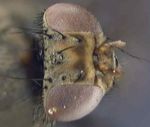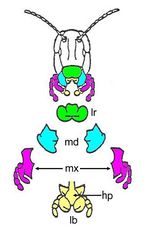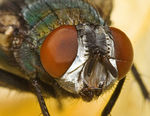Difference between revisions of "Insect Structure and Function"
Jump to navigation
Jump to search
| Line 192: | Line 192: | ||
**Sperm remains viable for most of the female's life cycle | **Sperm remains viable for most of the female's life cycle | ||
[[Category:Insecta]][[Category:To_Do_-_Parasites]] | [[Category:Insecta]][[Category:To_Do_-_Parasites]] | ||
| + | [[Category:To_Do_-_AimeeHicks]] | ||
Revision as of 16:08, 6 July 2010
Insect Body
- Covered by an exoskeleton
- Provides support and protection to the living tissues
- Acellular so is secreted by underlying epidermis
- The outer layer is called the epicuticle which is composed of proteins and covered by a waxy layer
- The inner layers are the endocuticle and exocuticle which are composed of protein and chitin
- Body is metameric (divided into segments)
- Divided into head, body and abdomen
- Articular membranes link segments allowing movement
Insect Head
- Capsule of fused plates at the anterior end of the body
- One large pair of compound eyes
- Honeycomb like corneal facets
- Three simple ocelli
- Dorsal to compound eyes
- One pair of antennae
Antennae
- Form varies amongst insecta
- E.g. long and segmented, short and squat etc.
- Hairs sometimes present
- Aristae (bristles) sometimes present
Mouthparts
- Modification depending on feeding method
- Insects which suck up liquified food have an expanded sponge like labellae
- Cannot penetrate skin
- Palps are also present which are sensory structures
- Insects which suck blood have long slender mouthparts for piercing skin
- Hypopharynx
- Mandibles
- Labrum
- Maxillae
- Larval mouthparts are prominent
- One pair of hooks
- Cephalo-pharyngeal skeleton
- Mouthparts help identify larvae
Insect Thorax
- Divided into three segments
- Prothorax, mesothorax and metathorax
- Each segment has one pair of legs attached
- One or two pairs of wings may be present on the mesothorax and metathorax
Leg
- Leg is attached to the body by coxa
- Trochanter
- Femur
- Tibia
- Tarsus, which is composed of several segments
- Claw
- Usually six-segmented
Wing
- Insects usually posess two pairs of wings
- Diptera have a reduced second pair of wings called halteres for balance
- Membranous outgrowth of the integument
- Strengthened by a network of veins comprising breathing tubes (trachea) and blood vessels
- The wing venation can be used for identification
- Longitudinal veins
- Cross veins
- Open cells
- Closed cells
Insect Abdomen
- Segmented
- Soft
- Appendages present
- Copulatory claspers
- Ovipositor
- External genitalia
Respiratory System
- Branching trachea strengthened by spiral thickenings in the walls
- Trachea communicate with outside via spiracles
- Spiracles on side of body
- Chitinous openings
- Muscular control so can open and close at will
- Mounted on stigmatic plates
- Lead to trachea
- Muscular contactions of the body wall produce respiratory movements
- Shape of spiracles and stigmatic plates used for species identification
Alimentary and Excretary System
- The precise shape of the gut varies between arthropods
- The Alimentary canal is divided into fore, mid and hind gut
- Foregut:
- Oesophagus
- Crop for temporary food storage
- Proventriculus
- Gizzard present in insects which eat solid food
- Muscular wall and teeth on inner surface
- Midgut:
- Stores food
- Secretes enzymes for digestion
- Outlet for malpighian tubules (equivalent of the mammalian kidney)
- Hindgut:
- Water resorption
Circulatory System
- Branching blood vessels
- Haemocoele
- General body cavity
- Equivalent to the capillary circulation in mammals
- Contains haemolymph
- Ostia (openings) in the blood vessel walls allow return of blood to the heart
Nervous System
- Small brain above the oesophagus
- Chain of fused ganglia running along the floor of the abdomen and thorax
- Nerves are given off from chain
- Complex nervous system
- Well developed visual senses
Fat Body
- Large structure
- Cells containing fat vacuoles
- Lines the body cavity and internal organs
- Equivalent to the visceral and parietal peritoneum in mammals
- Food reservoir during hibernation or starvation periods
Reproductive System
- Most insects have seperate sexes
- Reproductive organs are analogous to mammals
- Spermatheca present in females
- Accessory female sex organ
- Recepticle for spermatozoa
- Sperm remains viable for most of the female's life cycle



